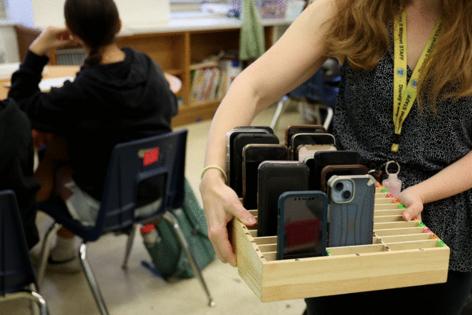Editorial: Want kids to learn? Start by removing smartphones from the classroom
Published in Op Eds
Hand your child a phone when you are ready for their childhood to end.
We’d suggest another spin on that online proverb: Let kids bring their phones to class when you want them to stop learning.
Last spring, Illinois Gov. JB Pritzker championed a bill banning cellphones from classrooms. It didn’t pass, but he’s indicated he’ll be renewing that fight.
More than 30 states now require districts to restrict student phone use in some way, according to reporting by Education Week. We think Illinois should join their ranks, and are encouraged that the governor is onboard.
“Social media, I mean this is probably the biggest danger to young people in this country,” Pritzker said Nov. 12 on the “Pivot” podcast. “We have got to put some limits (on). I tried to pass a law last spring, (and) we’re gonna try again.”
Good.
An Illinois Senate bill that fizzled out at the end of spring session wouldn’t ban phones in schools outright, but rather prohibit them in classes during “instruction time,” according to the legislation, and districts could tailor rules to best fit their community’s needs.
Some parents argue that their child should have access to a phone in case of an emergency. Given the amount of violence that has taken place in U.S. schools since the Columbine shooting, we understand that impulse. The Senate bill sensibly would’ve allowed for device usage in the event of an emergency.
The bottom line is that cellphones are disruptive to the learning environment, and devices have become constant sources of distraction, anxiety and online conflict. We’d even take it a step further and question whether kids in first grade need tablets and laptops. This isn’t an argument against assistive technology or structured digital instruction. It’s about unstructured access. We know plenty of youngsters who use school-issued laptops to play video games and watch YouTube at home or on the bus. Some kids are even watching videos in class.
We’re not Luddites, and we understand the argument that we should expose kids to technology so they’re able to navigate it instead of dooming them to a lifetime of asking the IT desk for support.
But we’ve essentially given kids TVs and telephones and expected them to have the self-control not to tinker with them when they’re bored. Most adults can’t even do that.
This is hurting them. A 2023 review of screen-time research found that excessive or unsupervised digital use is associated with weaker executive functioning, reduced academic performance and other developmental concerns.
According to the most recent proficiency scores, just over half of those in grades 3 through 8 met reading standards this year, while fewer than 4 in 10 high schoolers reached proficiency in math on the state’s IAR and ACT exams. These declines have unfolded in the same era that schools have struggled to manage unfettered digital access, though many other factors are also at play. A lot else has changed, too, specifically around standards-based reform and holding schools accountable, as Martin West, academic dean at the Harvard Graduate School of Education, told us in February when national test scores came out. But we know many teachers who will tell you cellphones are the bane of their existence as educators.
On this issue we share common ground with the National Education Association, which supports getting phones out of class — the union reports 90% of their members back such policies.
Lawmakers should act next session and give students a healthier environment to learn.
___
©2025 Chicago Tribune. Visit at chicagotribune.com. Distributed by Tribune Content Agency, LLC.
























































Comments